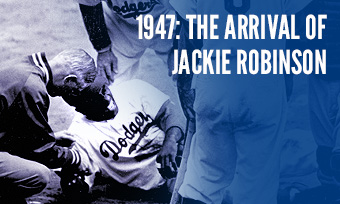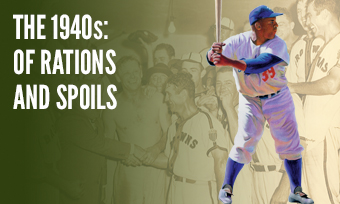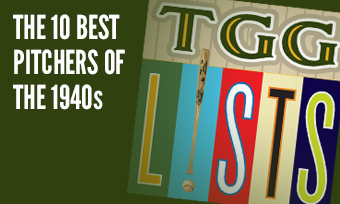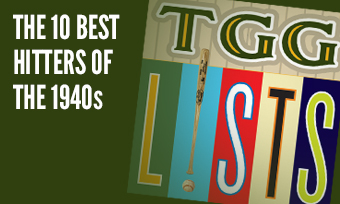The Yearly Reader
Leaders and Honors, 1947
Our list of baseball’s top 10 hitters and pitchers in both the American League and National League for the 1947 baseball season, as well as the awards and honors given to the game’s top achievers of the year.
The National League’s Top 10 Hitters, 1947
Bold type in brick red indicates league leader.
1. Johnny Mize, New York
Key Numbers: .302 average, 137 runs, 177 hits, 26 doubles, 51 home runs, 138 RBIs, 74 walks.
At age 34, Mize charged back to life with career highs in homers, RBIs and runs.
2. Ralph Kiner, Pittsburgh
Key Numbers: .313 average, 118 runs, 177 hits, 23 doubles, 51 home runs, 127 RBIs, 98 walks, .639 slugging percentage.
The Pirates brought in the left-field fence at Forbes Field to accommodate Hank Greenberg, but Kiner was the one who took full advantage and tied Mize for the home run title.
3. Whitey Kurowski, St. Louis
Key Numbers: .310 average, 108 runs, 27 doubles, 6 triples, 27 home runs, 104 RBIs, 87 walks, 10 hit-by-pitches, 19 grounded into double plays.
A year before his career collapsed under the weight of chronic arm issues, Kurowski became the last player not named Stan Musial to lead the Cardinals in home runs until 1958. He also managed to be the only National Leaguer to get hit by more pitches than rookie Jackie Robinson.
4. Bob Elliott, Boston
Key Numbers: .317 average, 93 runs, 176 hits, 35 doubles, 5 triples, 22 home runs, 113 RBIs, 87 walks.
In a year where many struggling players found renewed life via trades, Elliott was one of the more epitomizing examples after slipping badly the year before at Pittsburgh; in fact, his performance was good enough to earn NL MVP honors.
5. Stan Musial, St. Louis
Key Numbers: .312 average, 113 runs, 183 hits, 30 doubles, 13 triples, 19 home runs, 95 RBIs, 80 walks.
Stan the Man’s batting average was good for sixth in the NL, but from his viewpoint it was a disappointment; it would be his lowest season average within his first 14 years of play. Possible culprit: A bout with appendicitis.
6. Walker Cooper, New York
Key Numbers: .305 average, 24 doubles, 8 triples, 35 home runs, 122 RBIs.
The younger brother of St. Louis pitching standout Mort Cooper never hit more than 20 homers in any other of 17 big-league seasons; and don’t think the incredibly short distances down the lines of the Polo Grounds had anything to do with this outburst, because 23 of his 35 homers came on the road.
7. Willard Marshall, New York
Key Numbers: .291 average, 102 runs, 171 hits, 6 triples, 36 home runs, 107 RBIs, 67 walks.
Like Cooper, Marshall had a sudden splurge of power in 1947—he never hit more than 17 homers in any other season—but in this case the Polo Grounds did help, with 25 of his 36 dingers delivered at the Giants’ home.
8. Earl Torgeson, Boston
Key Numbers: 128 games, .281 average, 16 home runs, 78 RBIs, 82 walks.
Despite solid numbers acquired in just 128 games of play, Torgeson failed to get a single vote in Rookie of the Year voting.
9. Jackie Robinson, Brooklyn
Key Numbers: .297 average, 125 runs, 175 hits, 31 doubles, 5 triples, 12 home runs, 48 RBIs, 74 walks, 28 sacrifice hits, 29 stolen bases, 11 caught stealing.
How disruptive was Robinson upon opponents in his historic first season? Besides all the active numbers listed above, he also led the NL in reaching base on error.
10. Harry Walker, St. Louis-Philadelphia
Key Numbers: .363 average, 81 runs, 186 hits, 29 doubles, 16 triples, 1 home run, 41 RBIs, 13 stolen bases.
After hitting .237 in 1946 and .200 to start the year in Philadelphia, Walker needed a change of pace and got it big time in St. Louis, joining brother Dixie as the first siblings to win batting titles.
The American League’s Top 10 Hitters, 1947
1. Ted Williams, Boston
Key Numbers: .343 average, 125 runs, 181 hits, 40 doubles, 9 triples, 32 home runs, 114 RBIs, 162 walks, 29 intentional walks, .499 on-base percentage, .634 slugging percentage.
Williams became the second and last player to win a second triple crown in batting—and amazingly failed to win the MVP each time, in this case because Boston sportswriter Mel Webb left Williams completely off his ballot.
2. Joe DiMaggio, New York
Key Numbers: .315 average, 97 runs, 31 doubles, 10 triples, 20 home runs, 97 RBIs.
Webb’s spite gave Joe DiMaggio the award by a single point. Perhaps he and other voters presaged that 1947 would be the last dominant year put up by Joltin’ Joe, who would begin bowing to age and injury.
3. Tommy Henrich, New York
Key Numbers: .287 average, 109 runs, 35 doubles, 13 triples, 16 home runs, 98 RBIs, 71 walks.
At the age of 34, Henrich led the AL in triples for the first of two seasons.
4. Joe Gordon, Cleveland
Key Numbers: .272 average, 89 runs, 27 doubles, 6 triples, 29 home runs, 93 RBIs, 62 walks.
Looking dead at age 32 after hitting .210 in 1946, Gordon was shipped to Cleveland from the Yankees and awoke his numbers to prewar levels.
5. George McQuinn, New York
Key Numbers: .304 average, 84 runs, 13 home runs, 80 RBIs, 78 walks.
Age 38 and struggling with second-division organizations throughout his entire major league life, McQuinn looked refreshed within the Yankees’ winning mindset and became a pleasant surprise in the lineup.
6. Jeff Heath, St. Louis
Key Numbers: .251 average, 81 runs, 20 doubles, 7 triples, 27 home runs, 85 RBIs, 88 walks.
It was the Browns’ turn after the season to get rid of the veteran Heath, whose solid numbers were unfortunately outweighed by his difficult disposition.
7. Johnny Pesky, Boston
Key Numbers: .324 average, 638 at-bats, 106 runs, 207 hits, 27 doubles, 8 triples, 72 walks, 12 stolen bases.
Pesky became the first major leaguer to collect 200 hits in each of his first three years.
8. George Kell, Detroit
Key Numbers: .320 average, 75 runs, 188 hits, 29 doubles, 5 triples, 5 home runs, 93 RBIs.
Solid in time of war, Kell trashed former boss Connie Mack’s belief that he couldn’t play well in postwar baseball by posting the second of eight straight .300+ campaigns.
9. Roy Cullenbine, Detroit
Key Numbers: .224 average, 82 runs, 24 home runs, 78 RBIs, 137 walks.
In a time when walks were becoming more commonplace, fans and coaches excused Cullenbine’s poor batting average because he reached base more often via bases on balls.
10. Lou Boudreau, Cleveland
Key Numbers: .307 average, 79 runs, 45 doubles, 4 home runs, 67 RBIs, 67 walks.
With a magnet for second base, Boudreau led the AL in doubles for the third time in his career.
The National League’s Top 10 Pitchers, 1947
1. Warren Spahn, Boston
Key Numbers: 2.33 ERA, 21 wins, 10 losses, .677 win percentage, 40 appearances, 35 starts, 22 complete games, 7 shutouts, 289.2 innings.
Spahn won his first eight games, on his way to his first of a record 13 years with 20 or more victories.
2. Ewell Blackwell, Cincinnati
Key Numbers: 2.47 ERA, 22 wins, 8 losses, .733 win percentage, 33 starts, 23 complete games, 6 shutouts, 273 innings, 193 strikeouts.
Coming within two outs of duplicating teammate Johnny Vander Meer’s feat of two straight no-hitters was impressive enough, but so was a 16-game win streak in which he went the distance in 15 of them.
3. Dutch Leonard, Philadelphia
Key Numbers: 2.68 ERA, 17 wins, 12 losses, 235 innings, 57 walks.
One of the decade’s more underrated pitchers—certainly one of the most frustrating to hitters trying to connect on his knuckler—Leonard brought his act to Philadelphia and began a short but productive tenure with the Phillies.
4. Ralph Branca, Brooklyn
Key Numbers: 2.67 ERA, 21 wins, 12 losses, 43 appearances, 36 starts, 280 innings, 6 hit-by-pitches.
One of four NL pitchers to hit blackjack in the win column, Branca easily had his most successful season; he never won more than 14 in any other campaign.
5. Larry Jansen, New York
Key Numbers: 3.16 ERA, 21 wins, 5 losses, .808 win percentage, 42 appearances, 30 starts, 248 innings, 57 walks.
Jansen had the highest winning percentage by a rookie with 20 wins since Russ Ford in 1910.
6. Vic Lombardi, Brooklyn
Key Numbers: 2.99 ERA, 12 wins, 11 losses, 33 appearances, 20 starts, seven complete games, 174.2 innings.
A decent if fleeting presence amid baseball’s postwar landscape, Lombardi woke up from a wobbly first half with a 10-5 record and 2.64 ERA after the Fourth of July.
7. Al Brazle, St. Louis
Key Numbers: 2.84 ERA, 14 wins, 8 losses, 44 appearances, 19 starts.
A late-bloomer at age 33, the side-armed lefty—playing in his third year at the major league level—arguably had the best year in a solid seven-year stretch divvying his time between the rotation and bullpen.
8. Johnny Sain, Boston
Key Numbers: 3.52 ERA, 21 wins, 12 losses, 38 appearances, 35 starts, 22 complete games, 266 innings.
Strong run support (5.6 runs per start) helped Sain back over the 20-win mark—but he had himself in part to thank, hitting .346 over 107 at-bats.
8. Johnny Schmitz, Chicago
Key Numbers: 3.22 ERA, 13 wins, 18 losses, 38 appearances, 28 starts, 10 complete games, 4 saves, 207 innings.
Sain got the runs and thus the wins; Schmitz did not—a NL-worst 3.22 per start—and thus got the losses.
10. George Munger, St. Louis
Key Numbers: 3.37 ERA, 16 wins, 5 losses, .762 win percentage, 40 appearances, 31 starts, 6 shutouts, 224.1 innings.
You wouldn’t find a better lobbyist for night ball, as Munger went 12-3 with a 2.78 ERA at night (as opposed to 4-2 and 4.54 in day games).
The American League’s Top 10 Pitchers, 1947
1. Bob Feller, Cleveland
Key Numbers: 2.68 ERA, 20 wins, 11 losses, 42 appearances, 37 starts, 5 shutouts, 299 innings, 127 walks, 196 strikeouts.
Apart from his three no-hitters, Feller threw 12 career one-hitters—including two within a 10-day space early in 1947, that after producing a consecutive scoreless-inning streak of 30. Though his strikeout total paled in comparison to the 348 he collected the year before—suggesting his electric fastball was starting to lose some of its juice—he was still the class of the AL.
2. Hal Newhouser, Detroit
Key Numbers: 2.87 ERA, 17 wins, 17 losses, 40 appearances, 36 starts, 24 complete games, 285 innings, 110 walks, 11 wild pitches.
In a five-year period in which he led the AL in wins four times, Newhouser suffered through the odd year out because of poor run support (3.7 runs per start); he had the lowest ERA of a pitcher leading the AL in losses since 1918.
3. Joe Haynes, Chicago
Key Numbers: 2.42 ERA, 14 wins, 6 losses, .700 win percentage, 29 appearances, 22 starts.
All but exclusively a reliever earlier in the decade, Haynes took on the rotation spot more than not in 1947 and responded with a surprise ERA crown.
4. Joe Page, New York
Key Numbers: 2.48 ERA, 14 wins, 8 losses, 17 saves, 56 appearances, 2 starts, 141.1 innings.
Page succeeded Johnny Murphy as the Yankee closer—and managed to finish the year tied for second on the club in wins.
5. Walt Masterson, Washington
Key Numbers: 3.12 ERA, 12 wins, 16 losses, 35 appearances, 31 starts, 253 innings.
Masterson’s 34-inning scoreless streak in June was the longest by a Senators/Twins starter not named Walter Johnson.
6. Fred Hutchinson, Detroit
Key Numbers: 3.30 ERA, 18 wins, 10 losses, 33 appearances, 25 starts.
Almost as good a hitter as a pitcher—batting .263 over 650 career at-bats with just 30 strikeouts—Hutchinson produced a lifetime-best 18 wins as he stabilized his spot in the Detroit rotation for a number of years to come.
7. Joe Dobson, Boston
Key Numbers: 2.95 ERA, 18 wins, 8 losses, .692 win percentage, 31 starts, 228.2 innings, 11 wild pitches.
Dobson picked up the slack on a Red Sox rotation handicapped by the onset of career declines from former 20-game winners Tex Hughson and Boo Ferriss.
8. Phil Marchildon, Philadelphia
Key Numbers: 3.22 ERA, 19 wins, 9 losses, .679 win percentage, 35 starts, 21 complete games, 276.2 innings, 141 walks, 7 hit-by-pitches.
A former POW who lost 40 pounds while captive in Germany, Marchildon crucially pitched the A’s over the .500 hump for the first time in 14 years.
9. Spec Shea, New York
Key Numbers: 3.07 ERA, 14 wins, 5 losses, .737 win percentage, 178.2 innings.
The regular season numbers were impressive enough for the first-year right-hander, but he also became the first rookie to earn credit for victory at an All-Star Game, while winning two of three starts in the World Series; he would never participate in either event again.
10. Dick Fowler, Philadelphia
Key Numbers: 2.81 ERA, 12 wins, 11 losses, 36 appearances, 31 starts, 227.1 innings.
The Canadian-born right-hander had his finest year—and better support, a year after losing a league-high 16 games—but his record was still humbled with six one-run defeats.









